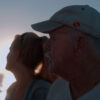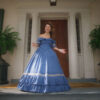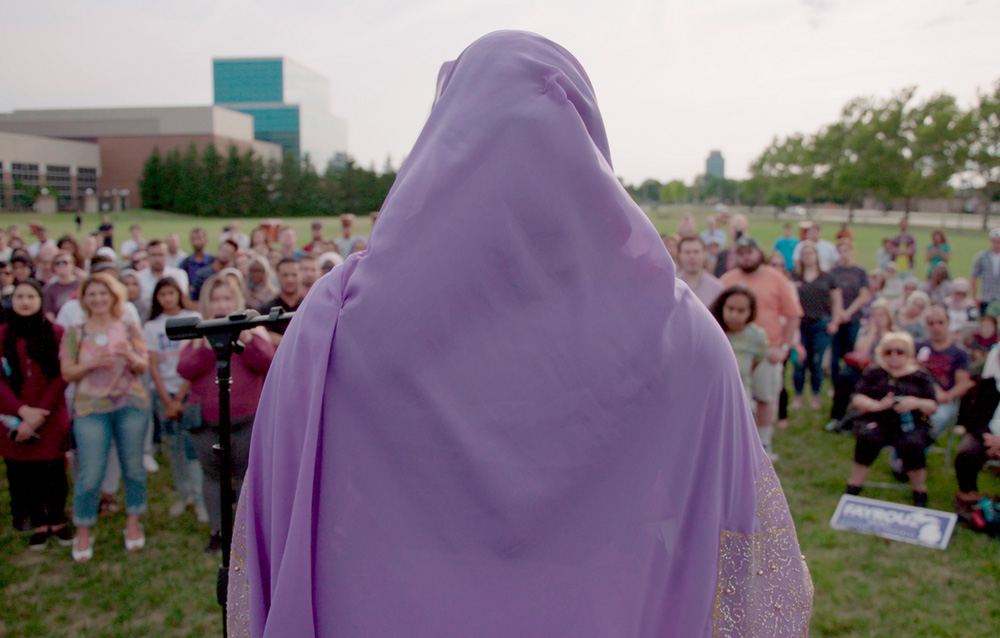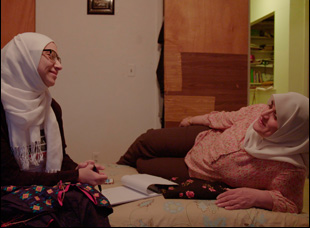If Nausheen Dadabhoy was going to change the way that Muslims in America are viewed by the country at large with her second feature “An Act of Worship,” it required shaking up the way their story has often been told. For months, she had been following a trio of women – Ameena, a civil rights attorney in Los Angeles, Khadega, a college freshman in Michigan who goes door to door in a bid to become a Democratic party delegate, and Aber, a community organizer in New York – as they rebelled against the Muslim travel ban imposed in 2017 by the Trump Administration, and while the footage itself was compelling enough and something that rarely made it to the screen before when these women in hijabs were commanding the public’s attention as strong, powerful leaders, Dadabhoy came to realize that the observational doc style itself was limiting, unquestionably capturing the moment, but not bringing audiences into it fully.
Almost immediately, “An Act of Worship” distinguishes itself by leading with a chorus of voices rather than just one at any given moment, underlining a barrage of images taken from home videos from their lives. Dadabhoy subverts the notion of a monolithic Muslim experience when no one she interviews is actually identified yet the personality of each individual comes through clearly, describing the myriad of ways that their life has been shaped by the fear they’ve felt in a nation they believed was welcoming to all religions but have been painted as terrorists over the past four decades. From schoolyard taunts to being held responsible for atrocities such as the Oklahoma City bombing and the Gulf War, members of the Muslim community speak with a clarity about what they’ve endured while one can see the lives they’ve put together in spite of it, with the film constructed around pivotal points in recent American history where the national sentiment shamefully tilted towards division rather than unity time and again.
While it documents a tragedy, “An Act of Worship” becomes galvanizing as Ameena, Aber and Khadega are naturally emerge as rays of light in the dark times that the film covers and the formal daring Dadabhoy shows to divorce the film from every other that came before it, clearing the mind and opening the heart to all those who make themselves vulnerable to her. On the eve of the film’s premiere at the Tribeca Film Festival, the director spoke about how she developed such an eyeopening structure for “An Act of Worship,” making her way across the country to get the full spectrum of the Muslim American experience and how working around the imposition of COVID led to one of the film’s most moving sequences.
One of my producers and I watched the 2016 election together, and pretty soon after that, I was like, “I think I want to make a film about the Muslim community.” Initially, it was under the Trump administration and he and I co-directed a short film also called “An Act of Worship” that looks at the immediate organizing around the Muslim ban. After that, we always knew we wanted to make a feature, but we really thought, “Okay, this community is obviously very diverse, experiencing different issues depending on where people are geographically, what their ethnic background is, and where their parents immigrated from,” so we wanted to have this broad national look and spent the next few months with one of my other producers Heba Elorbany, traveling the U.S. [where we] met all these different community activists and organizers. We found that there were Muslim women at the front lines of every kind of community organizing that was going on and we realized, ”Okay, they need to be the center of the film,” so we settled on three women [from] New York, LA, and Detroit, who we filmed with and for a long time, it was a verite film. We knew there’s a historical aspect of it, but we didn’t know how it was going to work out, and that was really something that came out in the edit.
The fact that it starts out with getting a sense of the community rather than with these three women, who gradually make their way into the picture, really shook things up formally so I could engage with it in a different way. Was that much of a breakthrough when you got away from the idea of a traditional verite film?
The film is very different from what I conceptualized. Initially, we had actually reached out to CAIR LA [The Council of American-Islamic Relations] and I was like, “Let’s film them for a year under the Trump administration,” and my producer Sofian Khan laughed at me, “You can’t film for a year. You need to film for much longer.” And we did end up filming for four years. But it’s interesting because during the edit, I kept going back to old journals to figure out, what did I think this movie was about? We knew really early on that we couldn’t make a film about Trump or the ban without recognizing that there was a history of the Islamophobia in this country that predates 9/11, so [we thought] “how are we going to showcase that?” What I also felt was really important was that we have four testimonials in the film — there’s the woman who was bullied as a child, the family’s home that was raided after 9/11, and two others that were always something that we knew that we wanted to do to really help people understand this is how policy impacts people personally.
All of those pieces were always there, but [during] the edit, I interviewed over 70 people across the country for our community voices. We collected home videos [because] we knew we can’t talk about what’s happening now if we don’t showcase what’s happened in the past, and we didn’t want to use news archival because that imagery has been so harmful for our community. So it was a lot of organic processes of like, let’s try this and [when it was] working okay, now we know we need more home videos. For a while, the whole movie was just my family’s home videos as placeholders.
There’s a real emotional sensation that emerges from that kind of archival material with the textures and occasionally warped colors that you have on a format like VHS. What was it like to work with?
We had so many hours and it was really difficult to find moments where people aren’t just happy and smiling and celebrating. Each of the sections where we’ve utilized the home videos are pushing and pulling on different moods that we’re trying to create, or emotions that the community is undergoing, so trying to find the language for what that could look like in this found footage was really fun. Also, if you watch the film closely, you’ll see that people grow up over the course of the home videos, so they start out as like kids and then they’re teenagers and then they’re graduating and having families, so we also see this progression of what the community looks like.

We had zeroed in on the main events that we wanted to cover in the film, so we were definitely asking people based on this timeline, but then the whole process of making the film was just talking to a lot of people in the community to understand what their experience was like – what kind of Islamophobia, if any, they were facing, and what policy might have impacted them. For instance, we interviewed people that had converted to Islam, were Latinx Muslim and African-American Muslim, or maybe their parents were in the Nation. There was such a wide swath of people that we interviewed, and we couldn’t incorporate all of their personal stories into the film, but all of their personal stories definitely helped us in shaping what the broader community story was saying.
How did you hone in on Aber, Khadega and Ameena specifically to follow with a camera?
Ameena was the first person that we started filming with and that was just luck. She was the lead attorney at the Council on American-Islamic Relations, and my sister used to work as an attorney with her at CAIR LA. When the airport protests were happening, I had actually gone as a protester, and I [thought], “But let me take my camera. Maybe something will happen.” And I saw [Ameena] at the airport and was just like, “This woman is amazing,” so we just started filming her — luckily, she said yes in that moment — and continued to let us film with her for many years. Then with Khadega and Aber, we had a few activists that we knew very well [through] Hussam Ayloush at CAIR LA, who is very well respected in the activist community nationally. We had asked him to make introductions for us to different communities in the U.S. and that was very important to have that stamp of approval.
There’s a lot of people, a lot of Muslims too, who want to make films about the community, but people in our community have been so misrepresented that they’re very hesitant, so [Hussam] really opened a lot of doors for us and it was just like a snowball effect of talking to one person and then they lead you to another person. Then we traveled to 20 different cities and really just figured out what’s the issue that people are working on, what are the different geographies that will enrich the story? Detroit and New York were important ones, and through a lot of this groundwork, we met Aber and Khadega and I think you can see on screen that they’re both very compelling, so they were just a really good fit.
There’s a really moving sequence towards the end of the film that brings home the effects of what effects U.S. policy has had on separating Muslim families that had to be a challenge to bring together when it involves filming both here and abroad. What was it like to figure out?
When we look at the Patriot Act, there’s a recreation that we did [for one sequence of the film] and initially the idea had been for each of these testimonials to be a recreation — the school bullying one, the FBI raid, the [story about] countering violent extremism, and the [Muslim] ban. That was something that we were hoping to film in 2020, but the pandemic made that impossible, so I really went back to the drawing board and thought about, what I considered iconography related to Americana? Being on a school playground, to me, is a very American thing, and [a] family dinner and it gets interrupted by a raid, and a young girl writing in her diary after school. And I would always see family portraits of white families – there were things that I always thought of and associated with white people and didn’t really associate with my community or culture, like we had all these family portraits from Pakistan, but I had never delved into them – white heteronormative culture was what all of us are inundated with. So [when] we’re talking about families that are separated, we really wanted to visualize what that separation looks like with a family portrait.
It was really breathtaking. After carrying this around with you for some time, what’s it like to start to get out into the world?
Today has been really interesting because I think you and all the journalists that we’ve spoken to are the first people that are seeing the film that are not people that I know, so I’m like, “Oh, this is so strange,” and I think everybody feels this way, but it’s like your darling child going out into the world. It’s kind of terrifying, but also really exciting. It hasn’t sunk in yet that it’s done, but maybe it will on Thursday when we see it with an audience.
“An Act of Worship” will screen at Tribeca on June 9th at 5 pm at the Village East, June 10th at 6 pm at the Cinepolis Chelsea and June 12th at 8:30 pm at the Tribeca Film Center.





